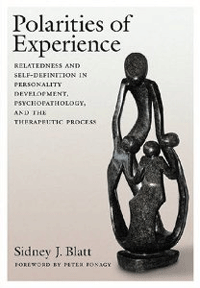Polarities of Experience: Relatedness and Self-Definition in Personality Development, Psychopathology, and the Therapeutic Process

“Polarities of Experience: Relatedness and Self-Definition in Personality Development, Psychopathology, and the Therapeutic Process”
By Sidney J. Blatt
American Psychological Association
Washington, D.C., 2008
Author displays depth of knowledge
Reviewed By Paul Efthim, Ph.D.
Yale psychologist Sidney Blatt is a phenomenon.
Over the course of a distinguished research career spanning five decades, Blatt has churned out more than 200 scholarly publications. Best known for research on depression, schizophrenia and personality development, he also trained as a psychoanalyst. His work has been praised for its theoretical and clinical depth as well as its methodological rigor.
Blatt’s most recent book is also his most ambitious. “Polarities of Experience” puts forth compelling evidence that depression, personality disorders and other psychological problems can be linked to tensions between relatedness and self-definition in personality development.
Blatt presents a “dynamic structural developmental model” focused on the dialectical tension between two threads of personality development: interpersonal relatedness (which Blatt terms the “anaclitic” dimension) and self-definition (the “introjective” dimension). Across the lifespan, development unfolds as a complex, synergistic interplay between these two fundamental polarities in human experience.
Not only does development oscillate between these two dimensions, but progress along one developmental line sets the stage for future gains on the other. As the author explains, “Meaningful and satisfying relationships contribute to the evolving concept of the self and a revised sense of self leads, in turn, to more mature levels of interpersonal relatedness.”
His research has found that in the normal range, people typically display a somewhat greater emphasis on one or the other of these two dimensions, with preferred styles of cognition, defense and object relations. In the face of biological predispositions and severely disruptive experiences, however, this normal dialectical developmental process gets interrupted, leading to a defensive, exaggerated emphasis of one of these two dimensions at the expense of the other.
The implications of this model are highly relevant for clinical work. Psychological problems can be understood as compensatory exaggerations of the normal polarities of relatedness and self-definition rather than clusters of symptoms as in the DSM system.
For example, depressive experiences in the anaclitic dimension revolve around preoccupation with issues of relatedness – including trust, closeness, loneliness and dependency feelings. The focus is on feelings of abandonment, deep longings and efforts to restore connection.
In contrast, the primary concerns in the introjective dimension involve self-control, identity and self-worth. Patients whose personalities are organized around introjective concerns tend toward efforts to maintain a sense of self that is separate and distinct from others. Depressive disorders in the introjective dimension are characterized by attacks on the self in the form of self-doubt, self-loathing and guilt. Blatt discusses how anaclitic and introjective personality types tend to respond differently to various elements of the therapeutic process and makes recommendations about matching patients to different types of treatment.
The author groups the book’s chapters into four sections covering an overview of the model, personality development, psychopathology, and therapeutic considerations. Throughout each chapter, Blatt cites extensive research evidence while also masterfully integrating and comparing a broad range of modern personality and developmental theory. The book’s readability suffers at times from a tendency toward repetitiveness. Some readers will struggle with Blatt’s references to “introjective” and “anaclitic” patients when such labels can reinforce a binary view of character that does not fit with the complexity of human personality. For example, a person with OCD may certainly seem to fit the self-definition mold on one level while simultaneously struggling with important (though hidden) relational conflicts.
Overall, this outstanding book represents a major achievement. The eminent Peter Fonagy, in a glowing foreword to the volume, declares that “Polarities” may signify a paradigm shift in clinical psychology. While only time will tell, we are fortunate to have Sid Blatt to guide us through the territory of developmental psychopathology with such astonishing breadth and depth of knowledge. This book is highly recommended for teachers, students and clinicians interested in personality, development, and psychopathology. Both psychoanalytic and cognitive therapists will find this work highly useful.
Paul Efthim, Ph.D. is a licensed psychologist in private practice in Brookline, Mass. and holds a faculty appointment at the Boston Institute for Psychotherapy.
Learn more about the book: Polarities of Experiences: Relatedness and Self-definition in Personality Development, Psychopathology and the Therapeutic Process
